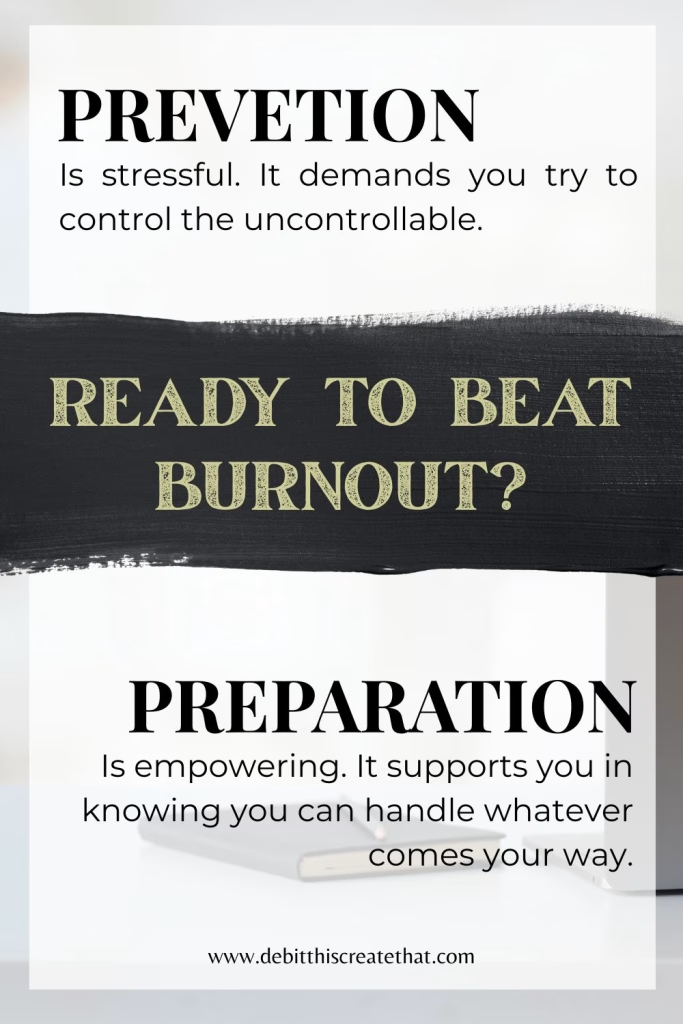I’ve learned quite a bit from my reign as a self-proclaimed burnout queen.
(So much in fact that I’ve written a Busy Season Survival Guide for the blog to share over a decade of those lessons with you!)
Those years gave me a lot of time to reflect, to try new things, and to fail fantastically at them.
I’m a public accountant, so every year I knew there was going to be a busy tax season. I knew when it would happen, when the deadlines would be, and how long it would last. Armed with this knowledge, every year I’d come up with a fantastic new plan to prevent burnout.
I Googled, I brainstormed, I reflected, and I built upon my personal collection of tips and tricks from colleagues, my own insights, and the tax season warriors on the internet.
Yet every year it got me (this year included, and in record time).
After all of these experiences, I finally realized the big mistake that kept me in a cycle of failure.
Did you catch it?
It was trying to prevent the burnout.
Why Trying to Prevent Burnout Doesn’t Work
What happens when we try to prevent burnout?
We find ourselves trying to control things that are outside of our control. That creates more stress and anxiety, which is clearly the opposite of what we’re going for here.
Trying to prevent burnout creates the illusion of control, which sets us up for disappointment and failure.
What can this look like? We might start by trying to anticipate all of the things that could cause us to burn out. Stress, overwork, and lack of balance are good starting points. So we’ll try to develop some zen habits, delegate some things off our plate, and maybe sign up for some yoga classes to hold ourselves accountable to chill out.
What if these preventative measures fail? The next logical step is of course to task ourselves with coming up with ways to prevent the preventative measures from failing.
Did we account for the surprise deadlines? Pivoting after mistakes? The unforeseen delays? Sudden illnesses?
No, we didn’t, so we’ll start playing out some “if-than” scenarios in an attempt to do so.
You can see how trying to prevent burnout involves trying to control a ton of variables and prevent them from impacting us to the best of our ability. Doing so actually requires more of our focus, energy, foresight, and work to be successful.
You know, on top of our actual work.
A better approach: aim to minimize the exposure to, intensity of, and frequency of burnout with preparation.

Why Preparation is Better Than Prevention
By aiming to minimize burnout, we make it manageable without overloading ourselves with all of the aforementioned responsibilities that come with trying to prevent it.
In a sense, we take our power back.
What is it they say about freedom? It doesn’t come from having ultimate control over every aspect of life. The freedom is in knowing that you can and will be able to manage, whatever happens.
So whatever happens, we want to have appropriate responses ready to go for when we:
- Know a busy season is coming.
- Start engaging in a pattern that you know might lead to burnout.
- Notice early signs of burnout.
- Feel that you are in the midst of burnt out.
We don’t want to be constantly watching for possible burnout triggers, and then trying to prevent them from happening.
We want to be consistently watching for burnout triggers, and know exactly how to respond as they’re happening.
To be clear, I’m not suggesting we just succumb to burnout, “suck it up”, and deal with it. I’m not saying it’s impossible to prevent, either! The point is that there’s a lot of undue pressure if our goal is to prevent burnout altogether.
(Why are we bothering to put ourselves through rounds of burnout each year? Sometimes it’s worth it!)
Knowing what you’ll do at each stage of your busiest seasons, and even upon the early signs of burnout, is the key to managing it effectively. This is why I wrote the Guide!
Part 2 of the Guide is on Practical Preparation, which provides some things you can do before a busy season starts, but the entire Guide is really intended to prepare you for all stages.
What are your go-to burnout management tactics? Share them below!





